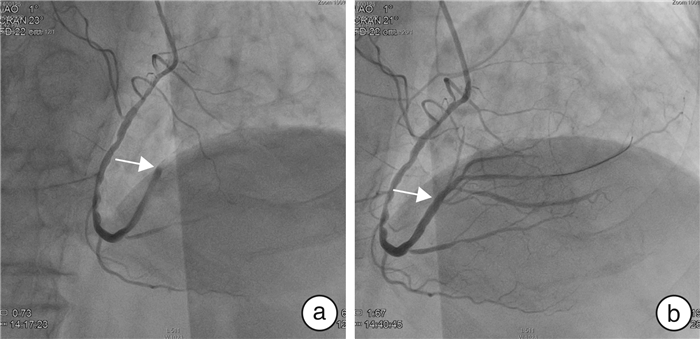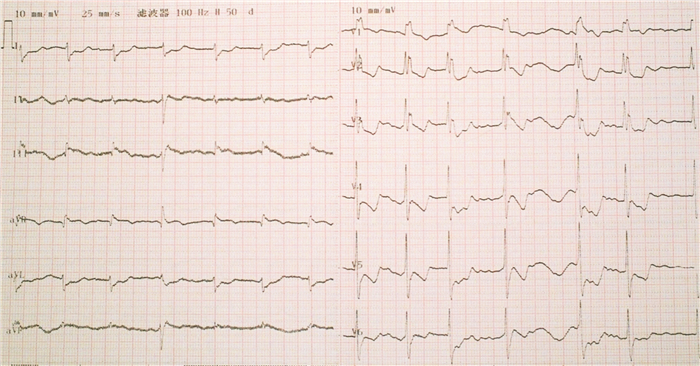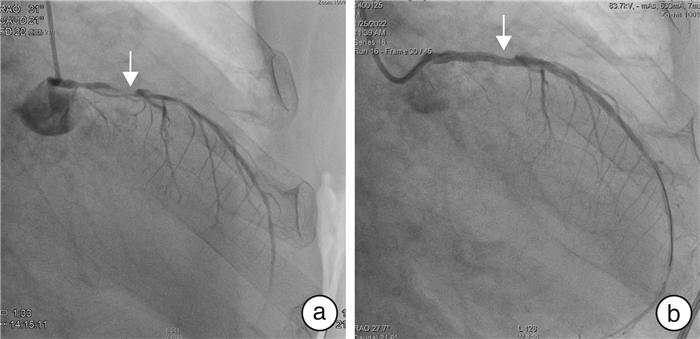Acute myocardial infarction combined with severe lesions of the three coronary arteries and cardiogenic shock after opening of target blood vessels, and intervention in non-target blood vessels again: a case report
-
摘要: 1例老年男性患者因持续胸闷1 h入院。既往有糖尿病和高血压病史。心电图示Ⅱ、Ⅲ、AVF、V7~V9导联ST段抬高0.1~0.2 mV。诊断为急性ST段抬高型心肌梗死,立即进行急诊经皮冠状动脉介入治疗(PCI),开通梗死相关动脉右冠状动脉左室后支。患者PCI后出现左心衰竭和心源性休克,在主动脉内球囊反搏支持下再次行急诊PCI处理罪犯血管左前降支。经积极治疗后,患者病情好转出院。Abstract: An elderly male patient was admitted with persistent chest tightness for 1 hour. He had a previous history of diabetes mellitus and hypertension. ECG showed Ⅱ, Ⅲ, AVF, V7-V9lead ST segment elevation up to 0.1-0.2 mV. Acute ST segment elevation myocardial infarction was diagnosed, and emergency percutaneous coronary intervention(PCI) was performed immediately, to open the infarction-related artery, posterior left ventricle branch of right coronary artery. After PCI, left ventricular failure and cardiogenic shock were developed. We handled the left anterior descending artery of the culprit vessel in second emergency PCI supported by intra-aortic balloon pump(IABP). After that, the patient's condition improved and was discharged from the hospital.
-

-
[1] Redfors B, Dworeck C, Haraldsson I, et al. Pretreatment with P2Y12 receptor antagonists in ST elevation myocardial infarction: a report from the Swedish coronary angiography and angioplasty registry[J]. Eur Heart J, 2019, 40(15): 1202-1210. doi: 10.1093/eurheartj/ehz069
[2] Freund A, Desch S, Thiele H. Revascularization in cardiogenic shock[J]. Herz, 2020, 45(6): 537-541. doi: 10.1007/s00059-020-04956-6
[3] 万俊, 徐凤, 程景林, 等. 低氧诱导因子1α在急性ST段抬高型心肌梗死患者左心室重构及预后中的作用[J]. 临床急诊杂志, 2022, 23(4): 242-246. https://www.cnki.com.cn/Article/CJFDTOTAL-ZZLC202204004.htm
[4] 中华医学会心血管病学分会, 中华心血管病杂志编辑委员会. 急性心肌梗死合并心原性休克诊断和治疗中国专家共识(2021)[J]. 中华心血管病杂志, 2022, 50(3): 231-242.
[5] Scholz KH, Maier SKG, Maier LS, et al. Impact of treatment delay on mortality in ST-segment elevation myocardial infarction(STEMI)patients presenting with and without haemodynamic instability: results from the German prospective, multicentre FITT-STEMI trial[J]. Eur Heart J, 2018, 39(13): 1065-1074. doi: 10.1093/eurheartj/ehy004
[6] Neumann FJ, Sousa-Uva M, Ahlsson A, et al. 2018 ESC /EACTS guidelines on myocardial revascularization[J]. Eur Heart J, 2019, 40(2): 87-165. doi: 10.1093/eurheartj/ehy394
[7] 陈凤英, 邓颖, 李燕, 等. 急性心力衰竭中国急诊管理指南(2022)[J]. 临床急诊杂志, 2022, 23(8): 519-547. https://www.cnki.com.cn/Article/CJFDTOTAL-ZZLC202208012.htm
[8] Lemor A, Basir MB, Patel K, et al. Multivessel versus culprit-vessel percutaneous coronary intervention in cardiogenic shock[J]. JACC Cardiovasc Interv, 2020, 13(10): 1171-1178. doi: 10.1016/j.jcin.2020.03.012
[9] Desch S. Revascularization strategies in cardiogenic shock after acute myocardial infarction[J]. Curr Opin Crit Care, 2019, 25(4): 379-383. doi: 10.1097/MCC.0000000000000623
[10] Thiele H, Akin I, Sandri M, et al. PCI strategies in patients with acute myocardial infarction and cardiogenic shock[J]. N Engl J Med, 2017, 377(25): 2419-2432. doi: 10.1056/NEJMoa1710261
[11] Thiele H, Akin I, Sandri M, et al. One-year outcomes after PCI strategies in cardiogenic shock[J]. N Engl J Med, 2018, 379(18): 1699-1710. doi: 10.1056/NEJMoa1808788
[12] Collet JP, Thiele H, Barbato E, et al. 2020 ESC Guidelines for the management of acute coronary syndromes in patients presenting without persistent STsegment elevation[J]. Eur Heart J, 2021, 42(14): 1289-1367. doi: 10.1093/eurheartj/ehaa575
[13] Fernandez Rico C, Konate K, Josse E, et al. Therapeutic peptides to treat myocardial ischemia-reperfusion injury[J]. Front Cardiovasc Med, 2022, 9: 792-885.
[14] Chen C, Yu LT, Cheng BR, et al. Promising therapeutic candidate for myocardial ischemia/reperfusion injury: what are the possible mechanisms and roles of phytochemicals?[J]. Front Cardiovasc Med, 2022, 8: 792592. doi: 10.3389/fcvm.2021.792592
[15] Hauguel-Moreau M, Barthélémy O, Farhan S, et al. Culprit lesion location and outcomes in patients with multivessel disease and infarct-related cardiogenic shock: a core laboratory analysis of the CULPRIT-SHOCK trial[J]. Euro Int, 2021, 17(5): e418-e424.
[16] 魏宇淼. 急性心肌梗死并发心源性休克的当代治疗策略及技术[J]. 临床心血管病杂志, 2021, 37(7): 591-594. https://lcxxg.whuhzzs.com/article/doi/10.13201/j.issn.1001-1439.2021.07.001
[17] 王功旭, 朱诗苗. 急诊PCI术后发生无复流与术前患者PLA值和肾功能变化的关系[J]. 临床急诊杂志, 2023, 24(4): 207-211.
-





 下载:
下载:


